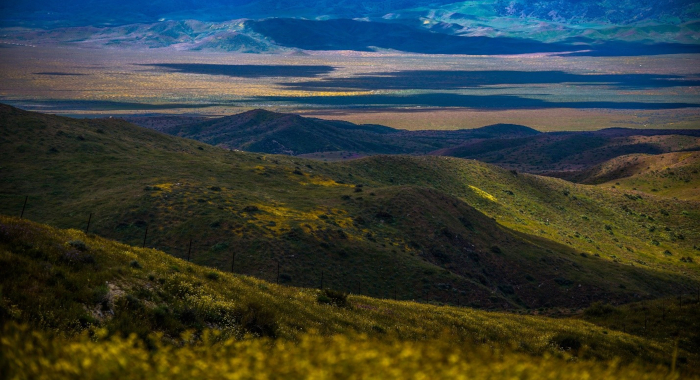Nearly half of California is protected in some land status that prevents most kinds of intensive human land uses. These lands support extensive natural habitats, and for many species, are a critical stronghold in an increasingly human-dominated world.
Yet, changes in the landscape in and near these places have left many in a degraded and precarious condition. Catastrophic wildfire, invasive species, and climate change threaten vast swathes of the state. Protected lands are becoming increasingly isolated by urban and agricultural development, roads, and other infrastructure. Such obstacles can limit a species’ ability to move to across the landscape and adapt to climate change.
Conservancy scientists are working to enhance the resiliency of protected lands in the face of rapid change, and to maintain the landscape connections necessary for plants and animals to adapt over time.


Butterfield, H.S., M. Katkowski, J. Cota, O. Sage, C. Sage, K. Easterday, D. Zeleke, L. Riege, S. Gennet, K. Lin, B. Leahy, M. Bell, M. Reynolds
Cattle grazing is the dominant land management tool TNC has to manage biodiversity and reduce the threat of catastrophic wildfire at the TNC's Jack and Laura Dangermond Preserve. This…Gavin M. Jones, H. Anu Kramer, Sheila A. Whitmore, William J. Berigan, Douglas J. Tempel, Connor M. Wood, Brendan K. Hobart, Tedward Erker, Fidelis A. Atuo, Nicole F. Pietrunti, Rodd Kelsey, R. J. Gutierrez, M. Zachariah Peery
This study examined spotted owl habitat selection after the King Fire in California using satellite tracking of 26 different owls . The authors found that whether severe fire was "good" or "bad" for…Christopher J. Lortie, Jenna Braun, Michael Westphal, Taylor Noble, Mario Zuliani, Emmeleia Nix, Nargol Ghazian, Malory Owen, H. Scott Butterfield
This paper evaluates how endangered species with highly restricted habitat needs and increasingly small population sizes (using blunt-nosed leopard lizard as our example), select and use available…Stephanie Dashiell, Mark Buckley, Dustin Mulvaney
In an effort to address climate change, California enacted a clean energy energy standard that is driving a market for significant amounts of renewable energy. To explore the economic benefits of…Annalise Taylor, Tanushree Biswas, John M. Randall, Kirk Klausmeyer, Brian Cohen
In Western North America, droughts are expected to increase in frequency and intensity as the region’s climate changes. Over past decades, land managers on Santa Cruz Island, California…Sophie S. Parker, W. Stanley Harpole, Eric W. Seabloom
This paper furthers our understanding of what makes some species rare, and others more common. The authors grew monocultures of 18 California grassland plant species and measured their growth and…Summary available in English and Spanish.
Grace C. Wu, Emily Leslie, Douglas Allen, Oluwafemi Sawyerr, D. Richard Cameron, Erica Brand, Brian Cohen, Marcela Ochoa, Arne Olson
California has ambitious climate and energy policies that call for the development of significant amounts of new zero-carbon energy by midcentury. The Power of Place study looks at multiple pathways…David Edelson, Angel Hertslet
There is an urgent need to increase the pace and scale of forest restoration in the Sierra Nevada and throughout the West to reduce the risk of high-severity wildfire and promote more resilient forest…M. Prunicki, R. Kelsey, J. Lee, Z. Xiaoying, H. Smith, F. Haddad, J. Wu, K. Nadeau
Jacob E. Lucero, Taylor Noble, Stephanie Haas, Michael Westphal, H. Scott Butterfield, Christopher J. Lortie
Previous work at the Carrizo Plain by this team in 2018 showed that native shrubs facilitated endangered blunt-nosed leopard lizard populations, and should be considered part of plans for habitat…Annika T. H. Keeley, Galli Basson, D. Richard Cameron, Nicole E. Heller, Patrick R. Huber, Carrie A. Schloss, James H. Thorne, Adina M. Merenlender
Connectivity conservation must move more rapidly from planning to implementation. We provide an evidence‐based solution composed of key elements for successful on‐the‐ground…Holmes ND, Spatz DR, Oppel S, Tershy B, Croll DA, et al.
Restoring islands by eradicating damaging, non-native invasive mammals such as rats, cats, goats, and pigs has repeatedly proven to be a high impact conservation action. New research…Rodríguez A, Arcos JM, Bretagnolle V, Dias MP, Holmes ND, Louzao M, Provencher J, Raine AF, Ramírez F, Rodríguez B, Ronconi RA, Taylor RS, Bonnaud E, Borrelle SB, Cortés V, Descamps S, Friesen VL, Genovart M, Hedd A, Hodum P, Humphries G, Le Corre M, Lebarbenchon C, Martin R, Melvin EF, Montevecchi WA, Pinet P, Pollet IL, Ramos R, Russell JC, Ryan PG, Sanz-Aguilar A, Spatz DR, Travers M, Votier SC, Wanless RM, Woehler E, Chiaradia A
Seabirds are amongst the most engaged species on our planet. Among these are petrels and shearwaters: species characterized by long ocean journeys for migration and feeding, and a dependence on…Joseph A. E. Stewart, H. Scott Butterfield, Jonathan Q. Richmond, David J. Germano, Michael F. Westphal, Erin N. Tennant, Barry Sinervo
Due to limited water resources, there is a global trend toward the retirement of farmland, especially in the San Joaquin Valley in California where the Sustainable Groundwater Management Act could…Annika T H Keeley, David D Ackerly, D Richard Cameron, Nicole E Heller, Patrick R Huber, Carrie A Schloss, James H Thorne, Adina M Merenlender
As climate change impacts wildlife and plants, species may need to access new habitats. Various approaches exist to plan to climate-driven habitat connectivity needs. We summarize the literature of…Sophie S. Parker, Brian S. Cohen, James Moore
This paper discusses changes in the conservation value of lands in the California Mojave Desert caused by renewable energy development that occurred between 2009 and 2016. The authors remotely assess…Michael F. Westphal, Taylor Noble, Harry Scott Butterfield, Christopher J. Lortie
Shrubs can play a key role in the structure of desert communities and can function as foundation species. Understanding desert shrub ecology is therefore an important task in desert conservation. In…